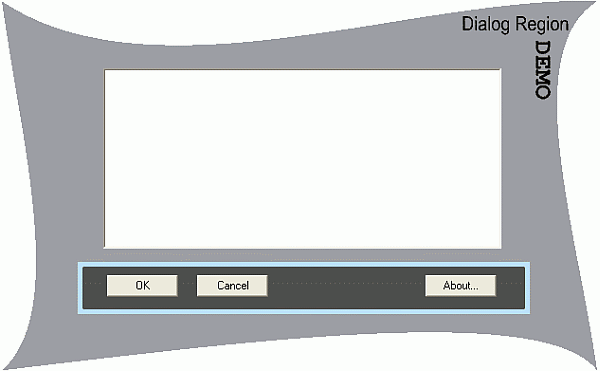CDialogRegionT - Skinning a WTL Dialog

Introduction
Having a hard time putting a skin on a WTL Dialog, or want to create transparent dialogs? From here on you'll have to write three odd lines of code! You can create dialogs with the same shape of the supplied bitmap with a transparency feature.
Background
Earlier, if you wanted to skin a dialog you had to handle WM_ERASEBKGND message and then write the paint routine by yourself.
BEGIN_MSG_MAP(CMainDlg)
MESSAGE_HANDLER(WM_ERASEBKGND, OnEraseBkGnd)
CDialogRegionT template takes all of the burden from the programmer and does everything by itself. There are a couple of more messages which are taken care by this template class. These are WM_CTLCOLORSTATIC and WM_NCHITTEST. Handling WM_NCHITTEST message in our case allows us to drag the dialog by clicking anywhere on the dialog; this is done by returning HTCAPTION in this routine.
LRESULT OnNCHitTest(UINT /*uMsg*/, WPARAM /*wParam*/, LPARAM /*lParam*/,
BOOL& bHandled)
{
// We handle this message only if we have set the region
bHandled = m_bIsRgnSet;
if(m_bDlgMove) // check if we can move the dialog
{
return HTCAPTION;
}
else
{
return 0;
}
}
Using the code
I attempted to make the code usage as simple as possible. After including the DialogRegion.h in your WTL dialog class you just have to follow these three steps:
- Inherit the WTL dialog from
CDialogRegionTtemplate class. C++class CMainDlg : public CDialogImpl<CMainDlg>, public CUpdateUI<CMainDlg>, public CMessageFilter, public CIdleHandler, CDialogRegionT<CMainDlg> { - In the message map add CHAIN_MSG_MAP entry to chain messages to this class
BEGIN_MSG_MAP(CMainDlg)
MESSAGE_HANDLER(WM_INITDIALOG, OnInitDialog)
COMMAND_ID_HANDLER(ID_APP_ABOUT, OnAppAbout)
COMMAND_ID_HANDLER(IDOK, OnOK)
COMMAND_ID_HANDLER(IDCANCEL, OnCancel)
CHAIN_MSG_MAP(CDialogRegionT<CMainDlg>)
END_MSG_MAP()
- Use
SetBkBitmapmethod in theWM_INITDIALOGroutine to specify the skin file. SetBkBitmap is an overloaded function and takes the color which is to be set as transparent (RGB(255,0,255)is default transparent color)
- If you are providing a resource bitmap:
C++
SetBKBitmap(IDB_BITMAP1);
HereIDB_BITMAP1is the bitmap resource identifier. - In case you are providing a bitmap file:
C++
SetBKBitmap("MyBitmap.bmp");HereMyBitmap.bmpis the name of bitmap file in the directory of the target executable generated.
- If you are providing a resource bitmap:
C++
Things to note
In the background section I did not discuss the WM_CTLCOLORSTATIC message. The CDialogRegionT template class uses this message to return the color for the static controls. In our case we will be using any color bitmap so the static controls needs to be drawn as transparent. So when the static controls are to be colored we set the background color as transparent and return hollow brush.
LRESULT OnCtlColorStatic(UINT /*uMsg*/, WPARAM wParam, LPARAM lParam,
BOOL& bHandled)
{
// We handle this message only if we have set the region
bHandled = m_bIsRgnSet;
if(m_bIsRgnSet)
{
::SetBkMode((HDC)wParam, TRANSPARENT);
return (LRESULT) GetStockObject (HOLLOW_BRUSH);
}
return 0;
}
I came across one problem: if I add the manifest for common controls 6, the static controls are drawn black. So you have to ensure that you are not using the common controls 6 in your project. You can choose not to add common controls manifest when you are creating the project using the WTL project wizard. If you already have a WTL project and upon adding CDialogRegionT class make the static controls to be drawn black, you can remove the common controls manifest from the .rc file.
License
This article, along with any associated source code and files, is licensed under The Code Project Open License (CPOL)
标签:WM,controls,Skinning,C++,Dialog,message,WTL,CDialogRegionT From: https://www.cnblogs.com/qzxff/p/16978959.html